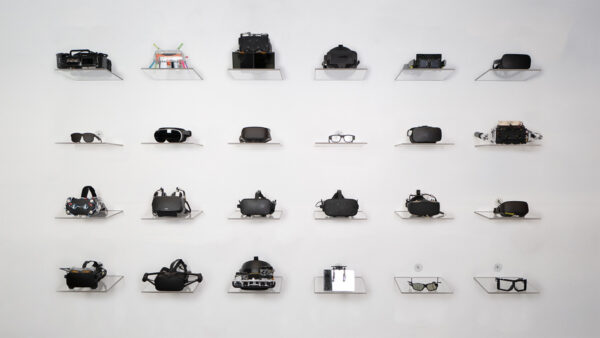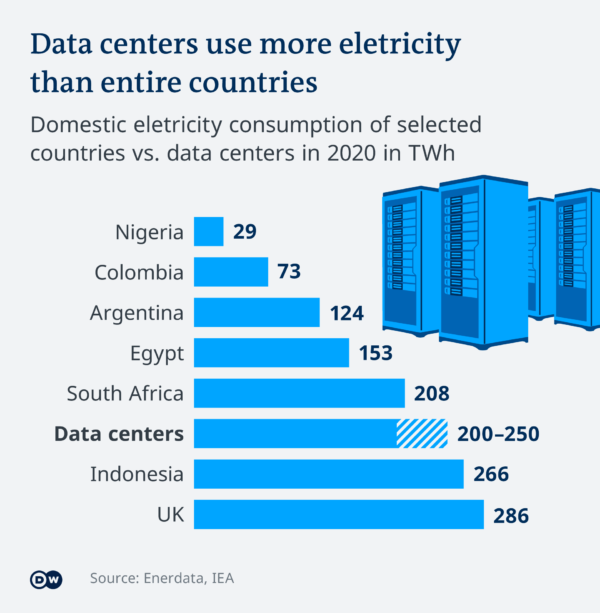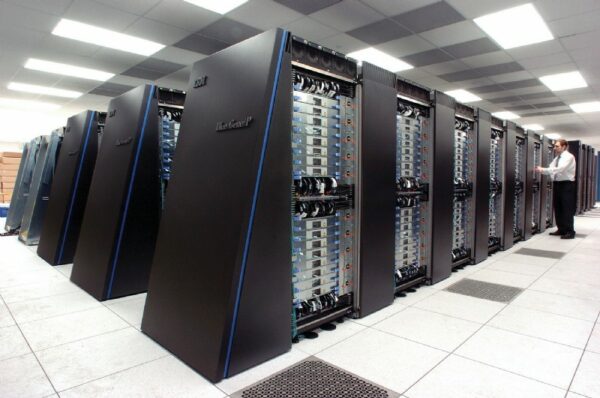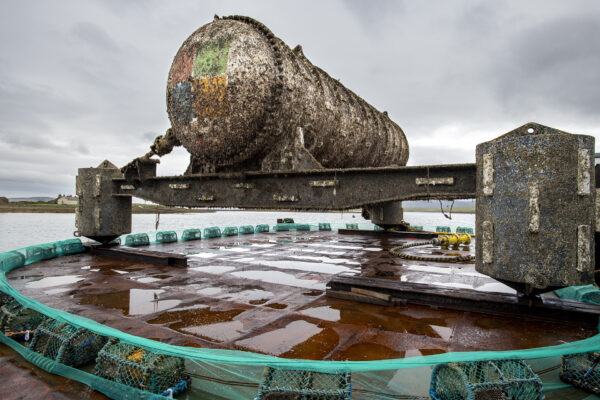In June 2022, Marina Otero won the Wheelwright Prize for her research proposal Future Storage: Architectures to Host the Metaverse, an examination of new architecture paradigms for storing data. Marina’s research takes, as one of its starting points, the question of how we can host and maintain the metaverse, when our digital infrastructures, our data centres and internet cable networks, are reaching their limits and putting pressure on already depleted ecological resources. In this interview, Marina and I discuss her upcoming research, looking at data storage infrastructures on a global scale, and how we can reimagine the metaverse, it’s architectures, and it’s potentialities.
Margarita Osipian: I wanted to interview you because of our current research that we’re doing with The Hmm on the metaverse and because I saw that you won the Wheelwright Prize for your research project on architectures to host the metaverse. One thing that we ran into when starting our research was the definition of what the metaverse is, which is this kind of slippery thing. So I started to work with this definition that ‘the metaverse’ is used to describe the concept of a future iteration of the internet that’s made up of persistent, shared, 3D virtual spaces, that are linked together into a virtual universe. And I was wondering if you have any starting definition of the metaverse that you are working with? How do you conceptualise this idea in your head of what the metaverse is, since you also use that terminology in your research?
Marina Otero Verzier: I am purposefully loose about what I mean with the metaverse. Whatever the metaverse is or could be, I am interested in how to host it. What are the infrastructures and the bodies that host, power, and maintain it? Where does it exist physically? What type of resources does it consume? From where are these extracted?
MO: I like this flexibility and slipperiness, because one of the things that I noticed was this co-opting of the idea of the metaverse. Of course Facebook becoming Meta is the most obvious one. But there was a metaverse conference in June in Amsterdam, and it was this extremely corporate event. Most of the speakers were in the fields of advertising and branding, who were just trying to cement their own idea or definition of the metaverse. So I like that you also slip around it or move away from a set definition.
MOV: Yes, this approach allows me to have conversations with people moved by diverse motivations to the metaverse, commercial or emancipatory.
MO: Extending from what you touched on just now, I was reading a lot of articles written about the metaverse and trying to grasp how people were understanding it and its emergence. What I noticed is that there was so much focus on what it is going to look like. How are we going to be able to move inside of it? Is it going to be interoperable across different platforms? This is, in a way, very surface level. There was not much conversation about the tools we would use to connect to the metaverse. Are we going to use VR glasses, for example? Will we have full body suits? There was so little shared about how we can actually connect into this virtual space, and even less about the architectural infrastructures that would support it. That’s why I was really drawn to your research and wondering what led you to it. How did you come to be interested in doing this kind of work? You have quite a diverse research background, so I was wondering how you actually became interested in this specific topic?

MOV: At Het Nieuwe Instituut, we researched the impacts and possibilities of automation on bodies and ecosystems. We started in 2016 by looking primarily at infrastructures in the Netherlands and China— factories, greenhouses, dairy farms, and harbours—that were increasingly being automated. Our interest was to understand what type of spatial and societal changes they would bring and their impact on the environment, labour markets, fabric and socio-economic profile of cities, and architectural thinking.
These facilities are worlds within worlds, operating 24/7 regardless of circadian and seasonal rhythms and the climatic conditions surrounding them yet totally dependent on the access and availability to energy, infrastructure, favourable tax regimes, and labor conditions. We followed the infrastructures that connect automated spaces to the so-called cloud: data centres, cable landing points, and the territories where resources such as lithium are extracted to build up batteries and a myriad of components critical for their operations. As a result, our research moved from the Netherlands and China to Atacama and Portugal, and we gained perspective on the social and environmental impact of our datafied existences, and on the material realities of the cloud.
That is when I wondered how these infrastructures would host and support a metaverse if they are already stretched to their limits. We are reaching a point of potential insufficiency where we produce too much data, but it is no longer possible to construct more data centers, if not leaving an entire city without energy. This possibility has actually triggered bans on data centers in the Netherlands and Singapore. Suppose we are already reaching the limits of data storage, energy consumption, and environmental degradation, the limits of the modern idea of progress. In that case, how is it possible that we are even considering the existence of a metaverse based on low latency, continuous real-time feeds of information that would guarantee a smooth and immersive experience? How are we going to host this thing and run this thing?’ What transformations are needed? And are we sure we need this thing?

MO: That’s funny that you say that, because I’m working on an article for this dossier and the title was just “Who asked for the metaverse?”
MOV: That is a great question. Who asked for these things? The world is a nasty place, so I understand the need to imagine alternative worldmaking practices, the appeal of having spaces of performativity, or even rehearsal for different ways of being in the world. At the same time, by doing that through the metaverse, we put at risk the only world we all share—the physical world (if we can still call it like this). How, then, can we practice the metaverse without relying on extractivism, exploitation, and proprietary infrastructures? Can the metaverse function without lithium batteries, a growing number of data centres, CO2 emissions, energy, water, and land consumption?
MO: So in a way for you the metaverse is more like a kind of catalyst, that opens up these larger infrastructural questions. I’m just thinking about your research on automation. The popular culture understanding of the metaverse is almost this game-like virtual environment, where you have an avatar. But there’s also these understandings, if you look at it more from the commercial field or the corporate side, that there’s this digital twin and simulation infrastructures, for certain kinds of labour, which have already existed for many years. I’m wondering if you would expand the definition of the metaverse to also include all of these infrastructural aspects.
MOV: For me these are the testing grounds to rehearse different identities, to define yourself and others otherwise. These are the possibilities that I think are exciting. My work, as that of many others, encourages challenging the Cartesian categories and their borders. The metaverse could be imagined as a place where to embody and practice nuanced and multifaceted definitions of body, identity construction, relationality and architecture. However, most companies and institutions seem excited about developments such as the digital twin and other tools for predicting, calculating, and controlling futures. Fields of health, planning, and astronomy are also putting their hopes on those possible capabilities of the metaverse. They are investing in storing an immense amount of data for ever longer periods that could result in potent datasets, and in turn facilitating discoveries, forecasts concerning human illnesses, or the universe’s origins.
What does all this mean? We are storing data that still needs to be useful with the hope that it might be. We operate similarly in relation to energy. As philosopher Michael Marder claims, we conceive energy as something that the Earth holds or that our bodies and batteries store, which could eventually be released and put to work. This problematic conception of energy discards actuality in the interest of potentiality. It assumes the destruction of bodies and ecosystems while searching for and extracting energy in the name of progress. We gamble on the future while carrying out actions making that foreclosure the possibility of a future.
MO: I see that also in the deep ice storage in the arctic, which I only learned about a few months ago, which to me also holds this question. The GitHub Arctic Code Vault is there, storing a snapshot of all active code repositories, as well as historical and cultural data collected from around the world. You can really see this tension there in a way.
MOV: My work navigates between and connects heritage and future-oriented technologies. The problem with the digital space is its sense of limitlessness, and abundance, whose growth does not need constraints. And the metaverse is precisely that, imagining an internet without as many constraints as possible, a fully immersive experience. This notion of the limitless growth of the digital space is dangerous. The digital space also demands us to decide what to keep, what is relevant, and what should be preserved for future generations. I have had many conversations with game designers around when you reach a game’s limit. How the borders of the metaverse look like? Should we decide on a limit to its growth, and under which conditions?
MO: That is true, because with these games that are just algorithmically generating new levels, the game does have this feeling of being endless. And it is endless, in a sense, because what are the limits in that context?
MOV: Yeah, think of Roblox. These platforms promote endless creation and growth, a controversial idea for a moment when it is clear we have reached growth limits. How much longer can we continue using fossil fuels? How much can we continue extracting materials at the expense of communities and ecosystems? These prospects and questions could be overwhelming, and our despair—and compulsive desires—find a respite in the promise of this other world where we still have endless possibilities. I would say the metaverse is a costly, problematic, and irresponsible form of escapism.
But I also wanted to ask you: What is interesting to you about the metaverse? What is it that triggers your interest?
MO: That’s a good question. Well, for me, I found that it’s more this ‘why’ question that interests me. Why do we need this? Maybe because I’m actually not necessarily attracted to being inside of it?
MOV: Me neither!
MO: I’m one of the program advisors for IDFA DocLab and in that role I watch a lot of VR and immersive work, and at some point, after three hours of watching VR, it’s just completely uncomfortable. And then I tried to imagine what is interesting for people to be in this kind of environment, and what is this push for creating this kind of parallel world? The positive side is what you talked about—the same thing that Second Life also did, and that you have in Minecraft—that you’re allowed to create these alternative futures and try to imagine these other kinds of worlds and possibilities. But of course, the cynical side of me just sees it as a way to extract as much data as possible from people. Because if I’m sitting in my house I’m connected to certain digital devices, but it’s very different if I’m replicating those same actions inside of a completely digital space. To me it’s more trying to understand what people might be attracted to, and also these very corporate interests.
MOV: I agree with you! I don’t play video games, but I watch people do it. I’m curious about why someone is interested in spending so much time in those spaces. The same with VR—I would not imagine myself with the need or the appeal to inhabit this parallel world. I nevertheless enjoy experiencing and inhabiting parallel layers of reality when reading a novel, watching a film, or attending a theatre play. At the end of a long day, many of us feel the need to disconnect, or rather, connect to other experiences. Even when we sleep, we inhabit other dimensions. Are these also forms of escapism? Could be.
The metaverse sells the possibility to take this even further: a space that we can fully inhabit, where we will not be passive actors but have agency and more decision-making power than what we have in reading a novel or watching a movie or even just performing daily life activities. The metaverse is the ultimate consumer-oriented experience.
For this promise to manifest in all its potential, the industry has to put in place a vast infrastructural effort that is often obfuscated by the PR machinery. To give you an example, the smooth functioning of the metaverse cannot only rely on the hyperscale data centres located in remote locations. The latency problem requires shortening the distance between data centres and end users. As a result, there is a renewed interest in micro data centres, edge computing, and other decentralised infrastructure, which bring data storage and usage closer. We will likely have data centres in our houses or neighbourhoods and have to rethink how to power them and manage security and ownership concerns. It is simultaneously a banal aspect of the metaverse and, to me, the most fascinating to discuss.

MO: That’s why I was really drawn to your research. There is what I think is a very calculated lack of conversation about this, the ‘now’ part. It’s like what you were saying, it’s really marketed in this specific way that, in a way, is sort of positioned as this layer that sits on top of, or parallel to, our physical environment that we’re in now. But there’s an erasure of this conversation of the how: how does this built environment that we’re living in now alter and change in relation to the metaverse? When you were talking about data centres getting smaller and smaller, and having data centres in your house, it made me think of the privacy conversations we are having and ideas circulating like having your own server inside your house. In a way there’s a kind of positive potentiality in that aspect of it.
MOV: I am totally into that. I am talking about this with other people, particularly with Ippolito Pestellini. The decentralisation of the data centres could mean different forms of data governance, ownership, and management. Now, most of these data centres are either colocation (those who host companies’ servers on their premises) or one-company massive data centres like Google or Facebook. Both cases raise privacy: who owns and manages the data? In my research, I connect with communities fighting for the ownership of their data and protection against surveillance. Indigenous communities in Australia are at the forefront of these struggles. Recently, several indigenous-led data centres opened in the region. Controlling infrastructure means having a more prominent agency over data control, a critical autonomy. What if we would have home-bound data centres, cooperative, neighbourhood scale data centers where data is managed independently from companies—a sort of collectivisation of digital infrastructure, as Jonas Staal proposes with the case of Facebook?
The metaverse is not a space of endless possibilities. It is fragmented, and the infrastructure that will run it will also be. We saw it during the Travis Scott concert in Fortnite: not everyone was in the same space. The attendees were both physically and virtually in different digital spaces.
MO: Speaking of your research trip that you are going to take, you’re going to make this open source manual for global data centre architecture design. There are a few countries that were listed on your research proposal, and I was wondering what approach you’re going to take to research this on a global scale? How do you take into account the varied circumstances and infrastructures within the different localities that you’re visiting?
MOV: I will conduct a field trip to a series of spaces that epitomise contemporary transformations in data centre design. In Australia, my work focuses on indigenous-led data centres. In China, I will examine how several provinces include underwater data centres in their five-year plans. In Singapore, where there was a ban on data centres for two years, I will visit floating data centres and the infrastructure powering them, such as enormous floating solar panels. In the Nordic countries, I want to learn more about the impact of green energy infrastructures on the Sami communities. There are companies in California currently developing new models for storage that may substitute the lithium battery, such as DNA data storage or fluorescent dye storage. If we change the storage medium, we will change the entire architecture.
For every travel, I contact people who have been on the ground, conduct interviews, document spaces with photos, draw, and organise conversations with local cultural institutions. The outcomes will be various, among them an open-source publication that I hope will instigate debate and different approaches to the data centre and digital infrastructure design.
My first trips are to Sweden and Iceland this coming December.

MO: Maybe to wrap up, I just want to go back to this tension between this sort of obsession and need we have on an individual basis to store everything, to dump all your photos from your phone to your external hard drive when it gets full, and so on, and so on. That’s on the micro scale. And of course that tendency extends out to what you were talking about, the importance of storing certain kinds of data for future potential use. I’m wondering if you see the need for a parallel, maybe more cultural conversation about data storage. We know that companies collect so much data from customers and users, but they often don’t have the resources or even the systems currently in place to process, analyse, and make use of the amount of data that they’re collecting.
MOV: It is hoarding. We collect data because we know that it is a valuable resource. We collect and accumulate it as capital in case it is more precious in the future, even if we do not know why or for what. That is very problematic.
The fields of heritage, experimental preservation, and digital infrastructures should be brought together in conversation around data management. A city, an archive, or a museum collection, deal with history according to a set of values and notions of the relevance of materials for future generations. Deciding on what to keep is always tricky and entails disagreements and controversy. Those debates should also exist when we decide on data storage. To decide on what relation we want to have with data, we need forums for discussion, as well as for data literacy and governance.
I have to confess that I am a digital hoarder. I do not delete emails, documents, or photos because I may need them in the future. That type of thinking is so engrained that unlearning demands considerable effort. Society needs to go through the trauma of letting data go. Nevertheless, this would be in vain if companies, private and state institutions, keep on collecting enormous amounts of data in the name of security or for the sake of profit.
Instead of searching for more efficient, compact, and stable mediums for data storage, we should accept data corruption, decay, and disappearance. After all, the search for endless growth, accumulation, and obsolete ideas of progress have consistently put the world in trouble. The metaverse replicates and intensifies these same mistakes.